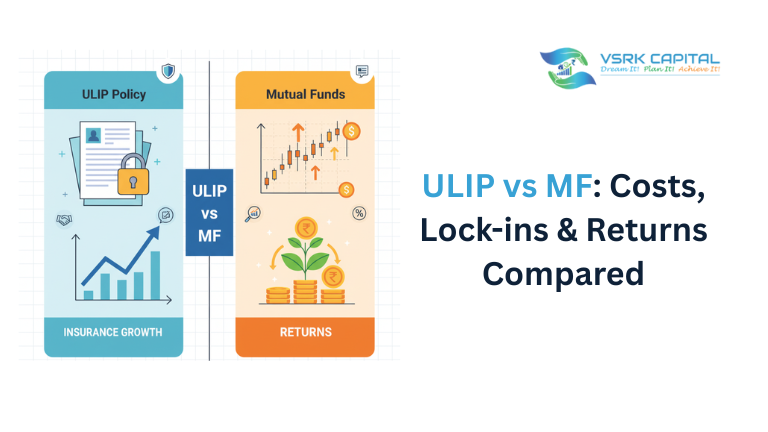Choosing between a ULIP and a Mutual Fund can make a huge difference in your wealth journey. Both are popular options for long-term wealth creation, but their cost structures, lock-ins, and returns differ. So, which is right for you? Let’s break it down.
In this blog, we’ll explore what is a ULIP, ULIP vs Mutual Fund, ULIP investment, cost structure of ULIPs, switching funds in ULIP, Section 80C deduction, and how these compare to mutual funds. We’ll also share insights from VSRK Capital to guide your decision.
What Is a ULIP?
A Unit Linked Insurance Plan (ULIP) is a financial product that combines life insurance with market-linked investment. Part of your premium goes toward life cover, and the rest is invested in equity, debt, or balanced funds.
Key features of ULIP investment:
- Provides life insurance coverage.
- Offers switching funds in ULIP, allowing movement between equity, debt, or balanced funds.
- Eligible for Section 80C deduction on premiums paid.
Wondering if this is right for disciplined long-term investors? Let’s see how it compares to mutual funds.
What Is a Mutual Fund?
A mutual fund pools money from multiple investors to invest in equities, debt, or hybrid funds. Unlike ULIPs, mutual funds focus purely on wealth creation and do not provide life insurance.
Benefits of mutual fund investment:
- Flexibility to invest in multiple asset classes.
- Higher liquidity compared to ULIPs.
- Transparent cost structure and fund performance.
If your goal is wealth creation with flexibility, mutual funds might be the way to go.
ULIP vs Mutual Fund: Cost Structure
| Feature | ULIP | Mutual Fund |
| Cost Structure | Premium allocation charges, fund management fees, mortality charges, policy administration fees | Expense ratio + exit load (if any) |
| Impact on Returns | High charges in early years can reduce returns | Lower charges, higher net returns over time |
Investor Tip: While mutual funds have simpler costs, ULIPs’ insurance component increases overall charges. Carefully evaluate the cost structure of ULIPs before investing.
Lock-ins: Flexibility of Funds
| Fund Type | Lock-in Period | Liquidity |
| ULIP | 5 years minimum | Moderate |
| ELSS (Mutual Fund) | 3 years | High |
| Other Mutual Funds | No mandatory lock-in | Very high |
Investor Insight: If liquidity matters, mutual funds are preferable. ULIPs are suitable for investors seeking long-term disciplined investment with insurance coverage.
Returns Comparison: Mutual Fund vs ULIP
| Fund Type | Potential Returns | Tax Treatment |
| ULIP | Moderate, depends on fund performance | Tax-free maturity after 5 years |
| Mutual Fund | Higher for equity, stable for debt | Capital gains tax applies; ELSS eligible for Section 80C deduction |
Key Point: Generally, mutual funds outperform ULIPs in net returns due to lower charges and higher flexibility.
Switching Funds in ULIP vs Mutual Funds
- ULIP Advantage: Switch between equity, debt, or balanced funds during the policy term.
- Mutual Funds: Switching possible via fund-of-funds or redemptions, without insurance charges.
Investor Tip: Want insurance + market-linked returns? Consider ULIPs. Seeking pure wealth creation? Go for mutual funds.
Tax Benefits: Section 80C and Beyond
- ULIP Investment: Premiums up to ₹1.5 lakh qualify for Section 80C deduction. Maturity proceeds after 5 years are tax-free.
- Mutual Fund: ELSS funds qualify for Section 80C deduction with a 3-year lock-in. Other mutual funds are subject to capital gains tax.
Should I Invest in ULIP or Mutual Fund?
| Feature | ULIP | Mutual Fund |
| Insurance Cover | Yes | No |
| Cost Structure | Higher (multiple charges) | Lower (expense ratio + exit load) |
| Lock-in Period | 5 years | 3 years for ELSS; others flexible |
| Returns Potential | Moderate | High for equity, stable for debt |
| Tax Benefits | Section 80C + tax-free maturity | Section 80C for ELSS; capital gains tax for others |
| Switching Funds | Yes | Yes (via fund-of-funds/redemptions) |
Investor Insight:
- Choose ULIP if you want insurance + investment, longer lock-in, and disciplined savings.
- Choose Mutual Funds if wealth creation, liquidity, and higher net returns are your priorities.
Conclusion & VSRK Capital Insight
When comparing ULIP vs Mutual Fund for wealth creation, the right choice depends on your goals, risk appetite, and investment horizon.
- Mutual funds usually offer higher net returns and flexibility.
- ULIPs suit investors seeking insurance + long-term discipline.
Evaluate your goals and choose wisely to grow your wealth efficiently. Always consider cost structure, returns, lock-ins, and tax benefits before investing.
VSRK Capital Insight:
According to VSRK Capital, a well-planned investment strategy considers both ULIPs and mutual funds based on your objectives. Their philosophy emphasizes goal-based investing, transparency, and long-term wealth creation. By balancing costs, returns, and tax efficiency, investors can maximize growth while staying protected.
Pro Tip: Wondering which suits you better? Take a moment to evaluate your financial goals, investment horizon, and risk appetite before making the decision.
FAQs
A ULIP is a financial product combining life insurance and market-linked investment.
Mutual funds often provide higher net returns due to lower charges, while ULIPs offer insurance protection.
Yes, most ULIPs allow switching between equity, debt, and balanced funds during the policy term.
Yes, premiums up to ₹1.5 lakh qualify for Section 80C benefits.
Choose based on your goals: ULIP for insurance + investment, mutual fund for wealth creation and liquidity.




